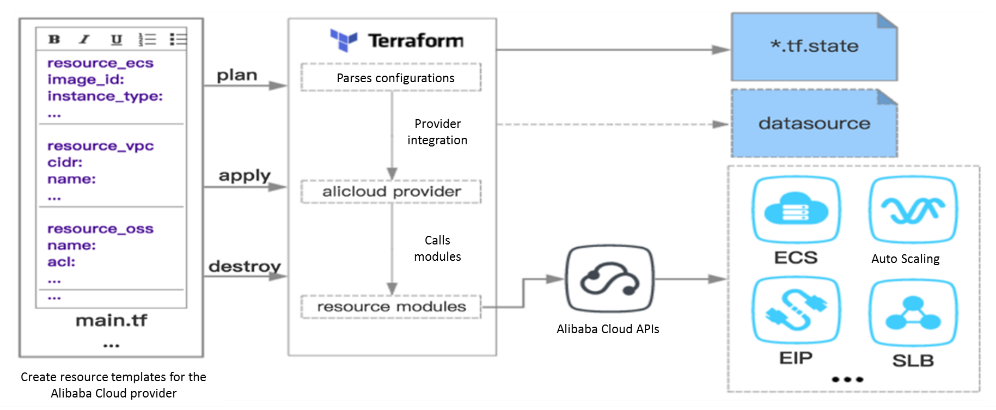By Anthony Merrington, Technical Support Engineer at Alibaba Cloud
If you're working in the IT sector, you've probably heard some of the hype surrounding Terraform by HashiCorp. But what exactly are Terraform's capabilities, and why should your business consider using it?
Put simply, Terraform is powerful infrastructure as code (IaC) tool that allows you to create, update, and control versioning of cloud infrastructure. With Terraform, you can generate and execute plans based on your desired end state and re-provision infrastructure based on configuration changes.
These are all great capabilities, but where Terraform really comes into its own is scenarios involving hybrid cloud and multicloud deployments. In days gone by, managing infrastructure deployed on different cloud providers as well as local data centers could quickly turn into a logistical nightmare, requiring great amounts of time and creating high operations costs. Terraform is an effective solution to this issue, allowing administrators to rapidly deploy and reconfigure infrastructure all from one place, and all at the same time. It is this ability especially that makes Terraform so powerful.
Alibaba Cloud provides integration with Terraform, which allows you to manage Alibaba Cloud infrastructure with greater efficiency. The actual method you use involves the usage of Alibaba Cloud APIs to perform operations on Alibaba Cloud services. You can learn exactly how this works and have a go at achieving a deployment yourself by following the step-by-step best practices tutorial.
The following are some typical use cases for Terraform:

Terraform allows you to provision and manage cloud resources with several key operations, such as plan, apply, and destroy, based on the target configurations of your infrastructure.
You can use the Alibaba Cloud provider to integrate Terraform with operations supported by Alibaba Cloud. As mentioned previously, Terraform uses Alibaba Cloud APIs to perform the actual operations on Alibaba Cloud services.
So now you know what Terraform is and how it works in practice on Alibaba Cloud. Without further digression then, here are the top 5 reasons why you should start using Terraform today:
Terraform applies to multi-cloud scenarios, where similar infrastructure is deployed on Alibaba Cloud, other cloud providers, or local data centers. Developers can use the same tool and configuration file to simultaneously manage the resources of different cloud providers.
Terraform can create configuration file templates to define, provision, and configure ECS resources in a repeatable and predictable manner, reducing deployment and management errors resulting from human intervention. In addition, Terraform can deploy the same template multiple times to create the same development, test, and production environment.
With Terraform, you can use code to manage and maintain resources. It allows you to store the infrastructure status, so that you can track the changes in different components of the system (infrastructure as code) and share these configurations with others.
You can reduce costs by creating on-demand development and deployment environments. In addition, you can evaluate such environments before making system changes.
Traditional click-ops methods of deployment used by organizations can take days or even weeks, in addition to being error-prone. With Terraform, full deployment can take just minutes. For example, you can provision multiple Alibaba Cloud services at a time in a standardized way. Both brand new deployments and migrations can be done quickly and efficiently.
In conclusion, Terraform provides many great benefits to businesses and developers. It can help you automate the orchestration of infrastructure across multiple cloud platforms, and help you reach the levels of agility you need to forge a path to success. Terraform is available in both an open source and enterprise version, and is fully integrated with all major cloud providers.
Learn more about Terraform by checking out the following free material:
9 posts | 4 followers
FollowAlibaba Clouder - September 10, 2020
Alibaba Clouder - July 2, 2020
Alibaba Cloud Serverless - August 23, 2022
afzaalvirgoboy - October 29, 2019
JDP - September 2, 2021
Alibaba Clouder - June 15, 2020
9 posts | 4 followers
Follow Alibaba Cloud Flow
Alibaba Cloud Flow
An enterprise-level continuous delivery tool.
Learn More Robotic Process Automation (RPA)
Robotic Process Automation (RPA)
Robotic Process Automation (RPA) allows you to automate repetitive tasks and integrate business rules and decisions into processes.
Learn More DevOps Solution
DevOps Solution
Accelerate software development and delivery by integrating DevOps with the cloud
Learn More Function Compute
Function Compute
Alibaba Cloud Function Compute is a fully-managed event-driven compute service. It allows you to focus on writing and uploading code without the need to manage infrastructure such as servers.
Learn MoreMore Posts by ClouderLouder